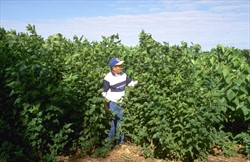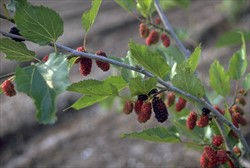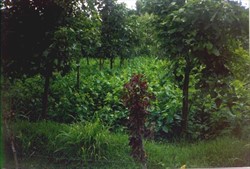Tropical Forages
Morus alba L.
Morus nigra L.
Morus rubra L.
Note: Most of the cultivated varieties are white mulberry (Morus alba L.), black mulberry (M. nigra L.), Indian mulberry (Morus australis Poir. syn. M. indica L.) and in North America, the American or red mulberry (M. rubra L.). Hybrid forms exist between Morus alba and M. rubra and others.
Morus alba L.: Morus alba f. tatarica Ser.; Morus alba var. constantinopolitana Loudon; Morus alba var. multicaulis (Perr.) Loudon; Morus atropurpurea Roxb.; Morus multicaulis Perr.
Note: No synonyms listed for M. nigra L. or M. rubra L. in GRIN.
Family: Moraceae tribe: Moreae.
The common mulberry is a handsome deciduous tree, 10‒25 m tall, of rugged, picturesque appearance, forming a dense, spreading head of branches usually wider than the height of the tree, springing from a short, rough trunk. The form of the tree can vary from pyramidal to drooping. The simple, alternate, stipulate, petiolate, light green leaves are cordate at their base but very variable in form, even on the same tree; some are un-lobed while others may be almost palmate; margin coarsely serrate to crenate, apex acute, acuminate, or obtuse. Flowers are unisexual, borne in the axils of leaves or on spurs on separate spikes, or catkins, which are small, more or less cylindrical and trees may be monoecious or dioecious. "Fruit", a syncarp (fleshy compound fruit composed of the fruits of several flowers) are white, lavender, deep red to black.
Africa: gewone moerbei, witmoerbei (white), swartmoebei (black) (Afrikaans); yeferenji injori (Amharic); el ttuut, tert, tuth (Arabic); nkenene (Luganda); mfurusadi, mforsadi (Swahili);
Asia: 桑 sang (M. alba), 黑桑 hei sang (M. nigra) (China); शहतूत shahtoot (Hindi), கம்பிளிச kambli chedi (Tamil), কব্রঙচাক অঙৌবা kabrangchak angouba (Manipuri), tut, tunt (Bengali); shetun (Gujarati), hipnerle, reshms chattu, shahtut, chinni, tut, tutri, siah tut (Hindi), kambli chedi, musukette, mussuketi (Tamil), tula (Sanskrit) (India); bebesaran lampung, bebesaran, mempaung, murbei (Indonesia); posa (Myanmar); kimbu (Nepal); amoras, amingit (Philippines); หฺม่อน mon (Thai); cây dâu tằm (Vietnam)
English: mulberry, common mulberry, Russian mulberry, silkworm mulberry, black mulberry, red mulberry
Europe: moerbezie (Dutch); mûrier, mûrier blanc, mûrier noir, mûrier rouge (French); weiße Maulbeere, schwarzer Maulbeerbaum, roter Maulbeerbaum (German); morera blanco, moral blanco, gelso bianco (Italian); amoreira-branca, amoreira-negra, moreira (Portuguese); selkovica belaja, selkovica cernaja (Russian); mora, moral blanco, moral negro, moral rojo morera blanca, morera negro (Spanish); vitt mullbär, svart mullbär, rött mullbär, mora (Swedish)
Native:
Asia: China.
Cultivated:
These three Morus spp. are now cultivated from temperate areas of northwest and central Asia, Europe and North America, through the tropics of Asia, Africa, and Latin America, to the southern hemisphere subtropics and temperate regions of southern Africa, South America and Australasia. There are mulberry varieties for many environments, from sea level to altitudes of 4,000 m ask, and from the humid tropics to semi-arid lands. In the Near East (with annual rainfall as low as 250 mm/year) and southwest of the USA, mulberry is produced under irrigation.
Forage
While mulberry leaves have been the traditional feed for the silk worm (Bombyx mori Lepidoptera; Bombycidae), they can also be fed in mixed diets to ruminants and other livestock. Mulberry is well suited for use as a fodder where it can be grown opportunistically around house-compounds, on spare pieces of land and along field edges. Integration of fish, livestock, and crop production in China has been refined for over 2,000 years. The system recycles resources, reduces organic pollution (livestock and poultry manure are good organic fertilizers for fish farming), and combines fish farming with mulberry cultivation for raising silkworms. The silkworm pupae are used as fish feed, and the worm faeces and wastewater from silk processing as pond fertilizers. Pond silt is used as fertilizer for fodder crops, which can in turn be used to feed livestock, poultry, and fish.
Environment
Mulberry trees are used as windbreaks and erosion control.
Other
The berries, called sorosis, are eaten by humans and have been used in traditional fabric dyeing, primarily purple and red in woollen fabrics. Young leaves and stems are used as a vegetable and mulberry leaf tea is claimed to have medicinal properties. The small trees have application in landscaping.
Soil requirements
Mulberries grow best in well-drained neutral soils, preferably deep loams. Shallow soils such as those frequently found on chalk or gravel are not recommended. The white mulberry, and to a lesser extent the red mulberry, are quite tolerant of poor soil.s
Moisture
Mulberries, mainly white mulberry, tolerate drought but if roots become too dry during drought, fruits drop before ripening.
Temperature
Mulberries grow well in temperate areas but lose leaves in winter. White mulberry is the most cold-hardy of the three species, although this varies from one clone to another. Some are damaged at 25° F, while others are unfazed at -25° F. Red mulberries are hardy to sub-zero temperatures. Black mulberry is the least cold-hardy of the three, although again cold tolerance seems to depend on the clone. In general it is limited to USDA Hardiness Zone 7 (0‒10° F average minimum) or warmer. In the tropics mulberries grow all year around.
Light
Mulberries require full sun for good production. Maximum yields in Costa Rica have been obtained in areas with plenty of sunlight.
Reproductive development
Mulberry trees are either dioecious or monoecious, and sometimes will change from one sex to another. Flowers are wind-pollinated and some cultivars will set fruit without any pollination. Cross-pollination is not necessary. In California mulberries set fruit without pollination.
Defoliation
Mulberries respond well to coppicing. In temperate areas foliage is harvested twice a year. In the tropics the most appropriate cutting interval is 90‒120 days. Cutting should not be done too close to the trunk since flush cuts are larger than they need to be and delay the sealing of the wound.
Fire
Black mulberry is reported to have some fire tolerance.
Guidelines for establishment and management of sown forages.
Establishment
The most common planting method worldwide is by stem cuttings, but in certain places seed is preferred. For cut and carry forage production for either silk worms or livestock.,plants can be planted at 75 cm spacing. Micro-stakes, with only one bud, take well in humid and warm conditions. Ease of vegetative propagation (rooting of cuttings) varies with species. The advantages of stem reproduction (cloning) are certainty of production characteristics, practicality in obtaining the material and easiness of planting. Male plants might be preferred when introducing foreign germplasm to new locations since this prevents involuntary expansion. As in most perennial forages, time and establishment costs (mainly for land preparation, planting and weed control) are critical aspects of successful introduction of mulberry.
Mulberries can also be grown from seed. Seed should be sown as soon as extracted from the fruit, although white mulberry seeds germinate better after storage 1‒3 months before planting. Seeds should be planted near the surface with a thin layer of soil and ashes spread over them in moist soil. Seeds germinate in 9–14 days, depending on the season. When seedlings are about 7.5 cm tall, they are thinned and weeded. As with other tropical perennial forages for cut-and-carry systems, planting by seed assures deeper roots with greater capacity to find water and nutrients which eventually results in higher biomass production and greater longevity. Seeds might be the most acceptable way of transporting, quarantine and store selected materials.
Fertilizer
Mulberry for forage responds very well to fertilisation.
In pure stands, mineral and organic Fertilizers (animal and vegetable manures) must be used to replenish the nutrients removed with the foliage in order to maintain a sustainable production. The association with legumes with effective N-fixing rhizobium can reduce N inputs and may be the most desirable combination for some farms, but even when recycling nutrients in animal manures, extra chemical Fertilizers are required for maximum production. Since the N level in soils is the major factor for mulberry growth, responses of mulberry to N fertilizers have been clearly demonstrated, both in inorganic and organic forms, with better responses to the latter.
Compatibility (with other species)
Mulberry has been tried for direct browsing in combination with grasses and clovers in Italy. In the tropics, it has shown to combine well with Gliricidia sepium in cut-and-carry systems and with Erythrina poeppigiana.
Companion species
A natural association of mulberry and livestock occurs in regions (e.g. Near East and Central Asia) where mulberry trees are kept for fruit production. Fallen leaves in autumn are consumed by domestic animals. Since fruit ripening happens in late spring or early summer, it may be possible to harvest leaves for forage one or more times before winter.
The only suggestion of utilising mulberry for direct grazing was a complementary association with Trifolium subterraneum for sheep and cattle grazing in Tuscany (Italy). Mulberry benefits from N fixation by the clover and contributes with high quality forage during summer. The association produces more forage over a longer period than individual pure stands.
Pests and diseases
Literature describes many pests and diseases of mulberry in silk producing temperate areas, but generally mulberry is a very healthy crop. Mulberry rust, caused by Aecidium mori, is the most destructive disease of mulberry in nurseries. While initially restricted to many Asian countries, it was reported in SW Nigeria in 2005, where it was found to be also infecting Centrosema molle and Chromolaena odorata growing within the mulberry plots. Nematode attacks have been observed in Yucatán, Mexico, on rocky calcareous soils under irrigation with pig slurry. Leaf-cutting ants can be a problem in certain areas.
Ability to spread
Mulberry trees are very easy to propagate and to transplant. Fruit (seed) bearing plants can be spread through birds.
Weed potential
In several countries, mulberries, mainly the white and black ones, are considered to have a high weed potential.
Nutritive value
Crude protein concentration in leaves can be considered similar to most legume forages, varying from 15 to 28% depending on the variety, age of leaves and growing conditions; fibre fractions are lower. A striking feature of mulberry leaves is mineral content, with ash values up to 25%. Typical P and Ca concentrations are 0.14‒0.24% and 1.8‒2.4%, respectively; K values in leaves and young stems are 1.90‒2.87% and 1.33‒1.53%, respectively and Mg 0.47‒0.63% (leaves) and 0.26‒0.35% (young stems). Digestibility of mulberry leaf is very high: in vivo (goats), 78–81% and in vitro, 90%.
Palatability/acceptability
One of the main features of mulberry as forage is its high palatability. Small ruminants avidly consume fresh leaves and young stems first, even if they have never been exposed to them before. Then, if the branches are offered unchopped, they might tear off and eat the bark. Cattle consume the whole biomass if it is finely chopped. Animals initially prefer mulberry to other forages when they are offered simultaneously, and even dig through a pile of various forages to look for mulberry.
Toxicity
There are no reports on toxicity; only a few apparent cases of bloating with cattle in Japan.
Feedipedia links
https://www.feedipedia.org/node/123 (White mulberry)
https://www.feedipedia.org/node/122 (Black mulberry)
Dry matter
Mulberry leaf yields of up to 10 t DM/ha/year can be expected. Maximum yields of edible material (leaves and young stems) and total biomass of 15.5 and 45.2 t DM/ha/year have been obtained.
Animal production
The value of mulberry is mainly seen as a supplement to low quality diets, particularly for small ruminants. There are reports of ad libitum DM intake of 4.18 and 3.44% of body weight for lactating goats and sheep, respectively, which is higher than in other tree fodders. Goats can produce between 15,000 and 20,000 litres of milk/ha in mulberry-based feeding systems. In another study, higher daily DM intakes of mulberry leaves were observed in sheep than in goats (3.55 vs. 2.74 kg DM/100 kg body weight). In Costa Rica, liveweight gains of criollo Romosinuano bulls fed Cenchrus purpureus increased to over 900 g/d when mulberry was offered as a supplement at 1.7% of their body weight on a DM basis. Other small herbivores, like rabbits, guinea pigs, iguanas and snails, could also be fed mulberry leaves.
The diploid M. alba (2n = 2x = 28) is the species most widely spread, but polyploid varieties, which originated in various research stations in Asia, show greater leaf yields and quality. In general, polyploid varieties produce more, thicker and larger leaves with darker green colour. The ploidy level varies among and within Morus spp. and range from the diploid M. alba to dexoploid M. nigra is (2n = 22x=308), the largest number of chromosomes among phanerogams. Mulberries are wind pollinated and some cultivars will set fruit without any pollination.
Fruits are picked or shaken on sheets when ripe. Mulberry seeds should be removed from the ripe fruit as soon as ready by squashing with plenty of water to separate seed from pulp. The seed can be dried and stored or stratified in sand for several months although immediate sowing is often recommended.
Application of isoproturon 70WP (1.00 and 1.25 kg a.i./ha) proved to be effective for weed control and had the least detrimental effect on plant growth and quality.
- Excellent tolerance to coppicing.
- Rapid regrowth and high yields.
- Diverse germplasm to suit environments from temperate to humid tropics.
- It can produce large quantities of nutritious forage, particularly in tropical areas.
- Requires high soil fertility.
- A good system for direct browsing is yet to be developed.
- Susceptibility to leaf rust.
Benavides, J.E. (1999) Utilización de la morera en sistemas de producción animal. In: Sánchez, M.D. and Rosales-Méndez, M. (eds) Agroforestería para la producción animal en América latina: Memorias de una conferencia electrónica realizada de abril a septiembre de 1998. Estudio FAO Producción y Sanidad Animal No. 143. Food and Agriculture Organization of the United Nations (FAO), Rome, Italy. p. 275–294. fao.org/3/x1213s/x1213s.pdf
Kamimura, C., Koga, S., Hashimoto, A., Matsuishi, N., Torihama, Y., Nishiguchi, T. and Shinohara, K. (1997) Studies on the factors influencing the mulberry productivity in fields. The Journal of Sericultural Science of Japan 66(3):176–191. doi.org/10.11416/kontyushigen1930.66.176
Sánchez, M.D. (ed). (2002) Mulberry for animal production. FAO Animal Production and Health Paper 147. Food and Agriculture Organization of the United Nations (FAO), Rome, Italy. fao.org/3/x9895e00.htm
Shayo, C.M. (1997) Uses, yield and nutritive value of mulberry (Morus alba) trees for ruminants in the semi-arid areas of central Tanzania. Tropical Grasslands 31:599–604. bit.ly/2xzQHBu
According to the mulberry´s long history of domestication, there is a vast number of cultivated varieties. For example, for Brazil alone the FAO Animal Production and Health Paper 147 lists 31 cultivars. Consequently this fact sheet abstains from reporting cultivar lists or promising accessions.










